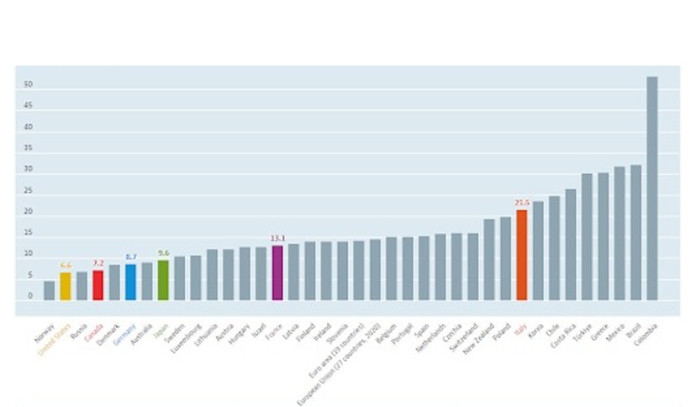Fiverr vs. Upwork: The Ultimate Showdown for Outsourcing Services in 202

As we move with the flow of the gig economy, everyone is talking about the big question: Fiverr vs. Upwork. Which one is most preferred? It is a trending topic for anyone looking to hire a freelancer.
Imagine this: a huge 1.5 billion freelancers are out there, constituting almost half of the global workforce, thanks to the data from the International Labour Organization. This is not just a change, it is a whole new world of work, highlighting the excellence of Fiverr and Upwork.
As a buyer, deciding between Fiverr and Upwork goes beyond just picking a service provider; it is a thoughtful deliberation that significantly influences a project result. Fiverr and Upwork offer different worlds: Fiverr brings a gig-based and fixed-rate, direct and not complicated model, while Upwork offers a more usual or typically proposal-oriented approach.
For me, getting to grips with the details of each platform, from the kind of services they offer to how their fees and interfaces work, is absolutely Essential.
TLDR:
Fiverr is generally considered the most user-friendly and easy platform for hiring Freelancers, and it is perfect for quick and efficient outsourcing of tasks. Its pre-defined Gig system simplifies hiring, offering clear pricing and deliveries.
Although Fiverr has additional costs for smaller transactions, its overall fee system and structure are simplified compared to Upwork’s, which includes a contract start fee and a more detailed billing system. Fiverr’s client-focused settlement process also adds to its request.
For those ranking ease of use and effectiveness, especially for one-time or small-scale projects, Fiverr is the preferred choice over Upwork.
Overview of the Freelance Market
The freelance industry has come too far in recent years, mainly because of the upward trend of digitization and the increase in remote work adjustment.
Fiverr and Upwork are the main supporters in the market where millions of freelancers earn their daily living. At the same time, different businesses find exchange talent pools.
The world workforce has shifted drastically. Recent statistics have revealed more than 46% of the global workforce is self-employed which is approximately 1.56 billion.
This figure really highlights the exceptional transformation with proficient experts ready to offer their specialized services to businesses and individuals like me who are looking for specific expertise.
Image courtesy: Payoneer.com
People are becoming financially more stable, and freelancing has become an available career choice. On average, freelancers earn about $28 per hour globally. This rate varies widely depending on the industry, skill level, and geographical location, but it emphasizes the potential for freelancers to earn stable income.
For example, web design is one of the most in-demand skills in the freelance market. This skill tops the list of popular freelancing skills, reflecting the digital age’s growing need for website development and design expertise.
Image courtesy: statista.com
The freelance workforce comprises over 73 million people in the United States alone. This number represents a substantial amount of the country’s total workforce emphasising the increase in dependence on freelance expertise across various sectors of the US economy.
This trend indicates a broader global movement towards freelance work, remolding how businesses operate, and individuals approach their careers.
How Does Fiverr Work
Fiverr has changed the freelance market with a unique structure, providing to both those who offer services and those seeking these services.
Understanding how Fiverr works is a key to boosting it full potential, whether you are a freelancer or a client.
Understanding the Roles: Buyers and Seller
“Buyers” are the clients and ‘Sellers’ are the Freelancers. You can sign up for any role (or both). Freelancer offers their services in a package called “Gigs”. They can also respond if buyers ask for help for their projects.
Fiverr Gigs: The Heart Of The Platform
Sellers in Fiverr create and list Gigs, fundamental bundled services offered at a set price. These Gigs cover various services, from graphic design to digital marketing. Buyers browse through these Gigs and purchase the one that suits their requirements.
Additionally, buyers can reach out directly to sellers for customized gigs or submit a request for a specific service, to which sellers can then respond.
Tiered Structure of Fiverr
Fiverr’s platform is categorized into three main tiers:
- The Main Fiverr Marketplace: This is a standard tier where most transactions occur, involving a wide range of Gigs across several categories.
- Fiverr Pro: It is an entirely appealing tier for professional freelancers who meet higher standards of good quality.
Platform Features and Tools
Fiverr offers many features and tools to improve the user experience:
- Profile Pages: This allows sellers to display their skills, experience, and Gigs.
- Talent Reviews: Buyers can easily access the quality of sellers’ work based on previous client reviews.
- Direct Messaging: This feature allows uninterrupted communication between buyers and sellers.
- Escrowed Payments: This ensures secure transactions.
- Customized Gig Quoting: It allows sellers to describe their offerings based on specific buyer requests.
Fee Structure on Fiverr
Fiverr is available without any primary payment for its estimated characteristics. However, the platform operates on a commission-based model. Sellers pay a 20% commission to Fiverr on all earnings, making sure that the platform’s sustainability and quality of service are on track.
Buyers, on the other hand, get a minimum service fee of 5.5% on each transaction, adding to the maintenance and development of the platform.
The Gig Model: Flexibility with Limitations
Fiverr’s Gig model mainly supports one-time purchases. This setup is best for specific, short-term tasks but less suitable for ongoing work, like hiring a freelancer for continuous daily or weekly services.
However, Fiverr offers some flexibility in this context, with options like Gig milestones or retrieving a Gig multiple times for long-term projects.
Fiverr provides a versatile, user-friendly platform specifically made to the needs of the modern freelance market. Whether you’re a seasoned freelancer or a business seeking specialized services, understanding how Fiverr works can pave the way to a world of opportunities in the gig economy.
How Does Upwork Work?
Upwork has established itself as a leading platform in the freelance industry, offering a comprehensive system for clients and freelancers to connect, collaborate, and complete projects. Understanding how Upwork operates is essential for anyone looking to push through this extensive marketplace, whether as a client seeking talent or a freelancer offering services.
For Clients and Freelancers: A Dual Approach
Upwork is designed to provide to clients and freelancers. Clients use the platform to create job postings in the Talent Marketplace, where they can hire freelancers for specific tasks or procure pre-existing services in the Project Catalog. This twofold strategy offers flexibility and a range of options to suit various project needs.
Project Catalog and Marketplace Listings
Freelancers on Upwork offer services covering more than 90 categories, from graphic design to copywriting. They use ‘Connects’ to submit proposals for jobs posted by the clients.
Additionally, freelancers can list one-off services in the Project Catalog, like logo design, that clients can buy.
Seamless Project Management and Collaboration
Upwork makes finding the right match, agreement, and project management easy. The platform is combined with various features:
- Billing Options: Both hourly and fixed-price billing to fit different project types.
- Project Milestones: For tracking the progress and managing the payments.
- Freelancer Profiles and Portfolios: Allowing clients to assess suitability.
- Reviews and Testimonials: Providing a perception of previous client experiences.
- Virtual Talent Bench: To structure and revisit favored freelancers.
- Communication Tools: Direct messaging, audio calls, and Zoom video calls.
- Scheduling: Incorporation of tools such as Calendly for effective meeting planning.
- Proposals and Contracts: enhancing the agreement process.
- Time Tracking: For accurate billing of hourly projects.
- Automatic Invoicing and Escrowed Payments: Ensuring safe and timely payments.
- Payment Protection: protecting both the party interests.
Cost and Fees
Using Upwork’s Talent Marketplace or Project Catalog does not need a price. Clients pay a service fee of 5% per purchase, with some qualified for a reduced 3% fee charge. On the other hand, freelancers pay service fees of 10% of their total earnings.
Fiverr vs. Upwork: Comparison While Hiring a Freelance
Fiverr and Upwork are distinguished as two of the most popular choices. But when it comes to hiring a freelancer, how do these platforms accumulate? Each has a unique approach and distinctive features that can greatly influence your hiring experience.
Ways to Find Freelancers
Finding freelancers on Fiverr is simple. Sellers create and list ‘Gigs’ that provide more details on their services, allowing buyers to browse and select the one that aligns with their requirements.
This model is excellent for buyers who prefer to explore predefined services and pick what best fits their needs.
Additionally, on Fiverr, buyers can ask for what they need by stating their project details, and Freelancers can reply with their ideas.
On Upwork, the process is more like a conversation. People who need work done describe what they want and those who can do it share their thoughts on getting it done.
This arrangement allows clients to access various proposals and select freelancers whose skills, experience, and bid align with their project requirements.
Upwork also provides a search option for clients to browse and choose from project Catalogs, and reach out to freelancers who match their needs or kind of qualifications.
Hiring a Freelancer
When hiring someone on Fiverr or Upwork, the process is easy and straightforward to follow, but they exhibit Substantial differences in approach execution.
Fiverr offers an easy, gig-based system for hiring Freelancers.
- Browse and select Gigs: The client starts by browsing through a large array of Gigs listed by freelancers. Each gigs list specific services, delivery timeline, and prices.
- Pre-pay for Gig Services: This involves clients who select a Gig pre-pay for the service. This payment is held by Fiverr until the job is completed, ensuring safety for both parties.
- Receive and Approve Work: The freelancer delivers the work as per the Gig’s specifications. The client then reviews the work and can request revisions if needed.
- Fiverr Releases Payment: Once the client is satisfied and approves the work, Fiverr releases the payment to the freelancer. This system ensures that clients only pay for work they deem satisfactory.
Upwork, on the other hand, offers a more personalized and interactive process:
- Browse Freelancer Profiles or Review Proposals: Clients can either browse through freelancer profiles to find a match or post a job and review proposals from interested freelancers.
- Speak with Top Freelancers: Before hiring, clients can communicate with top candidates. This step often involves discussing project details, clarifying expectations, and assessing the freelancer’s suitability.
- Enter into a Secure Contract: Once a freelancer is chosen, both parties enter into an Upwork contract. This contract outlines the scope of work, payment terms, and other essential details
- Place Payment into Escrow: The client places the agreed-upon payment into an escrow account to start the project. This payment remains secure with Upwork until the job is satisfactorily completed.
- Receive and Approve Work: The freelancer then completes and delivers the work. The client reviews it; like with Fiverr, they can request revisions as needed.
- Release Payment: Upon the client’s approval, the payment is released from escrow to the freelancer. This step marks the completion of the transaction, ensuring that the freelancer is paid only after delivering satisfactory work.
Ease of Use
Fiverr is known for its user-oriented content. The platform is simple to push through, making it easy for buyers to find and purchase Gigs. The simplicity of the process, from searching for services to placing an order, makes Fiverr easily reached even for those new to hiring freelancers.
Upwork, while comprehensive, can be slightly complicated due to its more detailed project posting and proposal review process. The platform offers a wider range of features, which, while beneficial for detailed project management, can be massive for first-time users.
Fees
Fiverr’s fee model is straightforward but includes additional costs for buyers. For every transaction, buyers are charged a service fee of 5.5%. This fee is applied on top of the Gig’s listed price, increasing the total cost slightly.
Additionally, for smaller Gig purchases, specifically those totaling $50 or less, Fiverr imposes an extra $2 fee. This is a significant consideration for buyers looking to outsource smaller tasks, as these additional charges can add up, especially for those who frequently engage with lower-cost Gigs.
Upwork, on the other hand, has an insignificantly different fee approach. It charges a standard transaction fee of 5% on all transactions. This fee is steady across all project sizes and types, making it predictable for clients to calculate their total costs.
However, there’s an expense advantage for some U.S. clients who pay via ACH bank transfer, as they may qualify for a lower transaction fee of 3%. Additionally, Upwork adds a $2.95 contract initiation fee for each new contract established with a freelancer. This fee is just perfect for Upwork and should be included in the total expenses when setting up multiple contracts with different freelancers in the space.
Security
On Fiverr, the payment is held in escrow and will only be released to the freelancer only when the project is completed, ensuring the security of buyers. The platform also has a conflict resolution center to handle disagreements and offers customer support and help where there is any issue. However, Fiverr is seemingly known for favoring the clients during this disagreement.
Upwork also holds payments in escrow, providing security measures for both parties involved. It offers a conflict resolution service and has a strict policy for freelancer verification and job posting validity. Upwork’s platform is designed to ensure high trust, making it a secure choice for long-term and short-term projects.
Fiverr vs. Upwork: Which One Is The Best For Hiring a Freelancer
When comparing Fiverr and Upwork for hiring freelancers, Fiverr often emerges as the more user-friendly and straightforward option.
Its system of Fixed Gigs simplifies the process of finding and hiring freelancers, making it highly suitable for clients seeking easy, fast, and effective ways to hire out tasks.
Clients easily browse, select, and pay for services with clear pricing and deliverables, saving time and reducing the complexity often involved with freelance hiring.
In terms of the platform’s structure and fee system, Fiverr’s approach, despite the additional costs for smaller transactions, is generally more clear and less cumbersome compared to Upwork’s model, which includes a contract initiation fee and a more complex billing system.
This simplicity, combined with Fiverr’s client-centric resolution process, offers effortlessness and security that is particularly attractive to many clients.
Overall, while both platforms have advantages, Fiverr stands out for those who value a streamlined, efficient process and a user-friendly interface when hiring freelancers.
Whether for quick, one-time projects or regular, small-scale tasks, Fiverr’s platform is designed to make a smooth and straightforward freelance hiring experience.
Key differences between using Fiverr and Upwork in hiring freelancers include:
|
Particulars |
Fiverr |
Upwork |
Winner |
|
Finding a freelancer |
|
|
Tie |
|
Hiring a freelancer |
|
|
Upwork: Fiverr is very easy and simple, but Upwork provides the chance for more customized job options. |
|
Billing methods (varies by country) |
|
|
Fiverr |
|
Fess |
|
|
Tie |
|
Ease of use |
Known for its user-friendly interaction. |
While comprehensive, it can be slightly more complicated. |
Fiverr |
Final Word
Both Fiverr and Upwork are great platforms in the freelance market with unique strengths.
Fiverr‘s simple and fixed-price gigs make it easy for fast tasks and small projects, while Upwork’s comprehensive approach fits long-term, refined projects. Your choice wholly depends on the nature of your work and the budget selection of the communication method.
The “Fiverr vs. Upwork” contemplation has no universal answer. It’s about finding the right fit for your match.
Whether you’re a startup looking for affordable solutions or a large business venture seeking top-tier talent, understanding the difference between each platform is key. Staying informed and versatile as the gig economy progresses will help you make the best choices for your outsourcing needs.
Happy Hiring!



